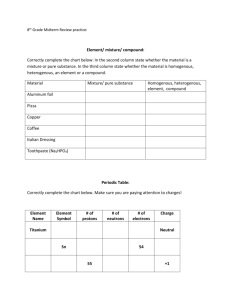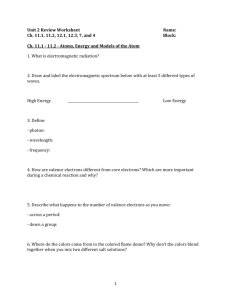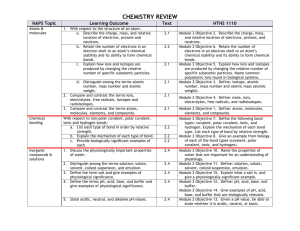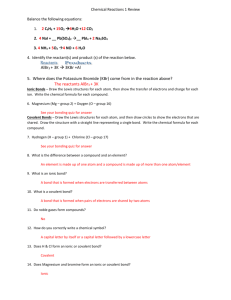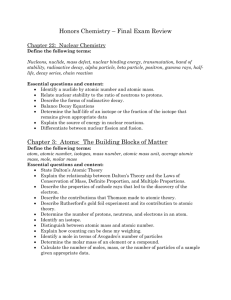Chemistry Mid-Term Review 2013-1014
advertisement
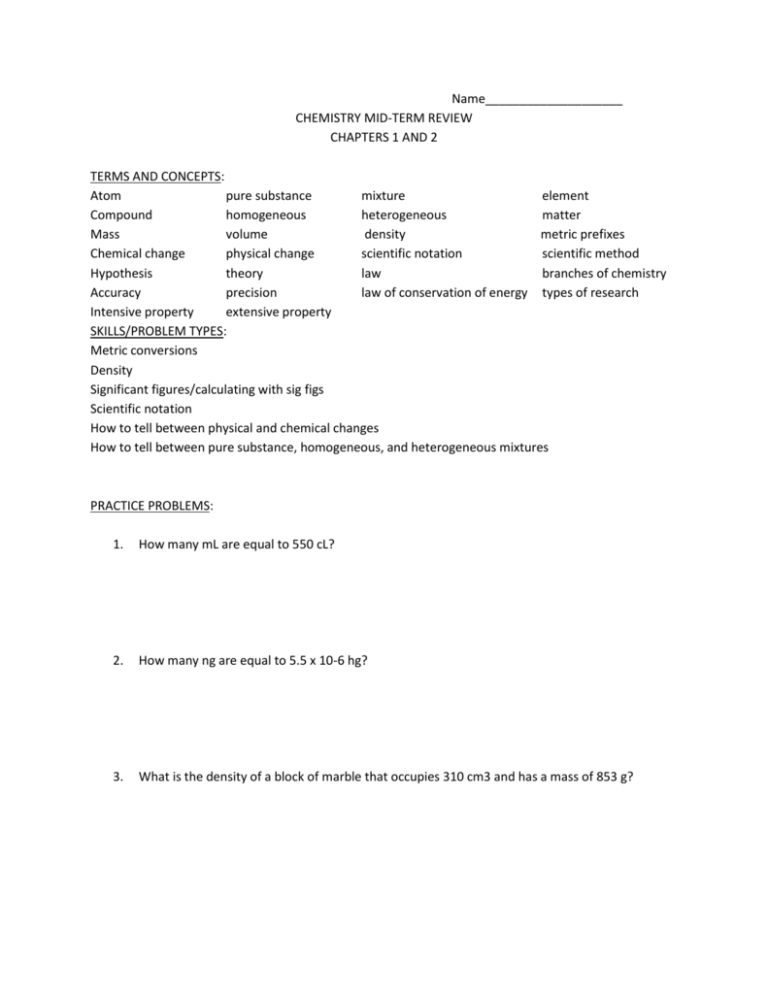
Name____________________ CHEMISTRY MID-TERM REVIEW CHAPTERS 1 AND 2 TERMS AND CONCEPTS: Atom pure substance mixture element Compound homogeneous heterogeneous matter Mass volume density metric prefixes Chemical change physical change scientific notation scientific method Hypothesis theory law branches of chemistry Accuracy precision law of conservation of energy types of research Intensive property extensive property SKILLS/PROBLEM TYPES: Metric conversions Density Significant figures/calculating with sig figs Scientific notation How to tell between physical and chemical changes How to tell between pure substance, homogeneous, and heterogeneous mixtures PRACTICE PROBLEMS: 1. How many mL are equal to 550 cL? 2. How many ng are equal to 5.5 x 10-6 hg? 3. What is the density of a block of marble that occupies 310 cm3 and has a mass of 853 g? 4. Diamond has a density of 3.26 g/cm3. What is the mass of a diamond that has a volume of 0.350 cm? 5. What is the volume of a sample of liquid mercury that has a mass of 76.2 g given that the density of mercury is 13.6 g/mL? 6. How many significant figures are in each measurement? a. 500 m _____________ c. 0.00005 m_______________ b. 0.0500 m ____________ d. 50 m ___________________ 7. Make the following calculation and report your answer to the correct number of significant figures please. a. 55.46 g - 28.9 g _________________________ b. 0.021 cm x 3.2 cm x 100.1 cm________________ c. 1.278 x 103 m2 / 1.4267 x 10 2 m_______________ 8. Put each number in scientific notation please. a. 0.005 _______________ b. 5 050 _________________ c. 0.00025 _________________ d. 5 200 000 ________________ Name________________ CHEMISTRY MID-TERM REVIEW CHAPTERS 3, 4, and 5 TERMS AND CONCEPTS: Law of definite proportions Nucleus Electron Mass number Orbital Quantum numbers (4) Pauli Exclusion Principle Mendeleev Group Main-group elements Lanthanides Electronegativity law of conservation of mass proton Rutherford isotopes ground state Aufbau Principle mole Mosely period Group Names (1,2,17,18) actinides ionization energy law of multiple proportions neutron atomic number Dalton excited state Hund’s Rule Avogadro’s number periodic law valence electrons transition metals alloy atomic radius SKILLS/PROBLEM TYPES: Istopes Molar conversions Electron configurations Periodic trends PRACTICE PROBLEMS: 1. Give the number of protons, neutrons, and electrons in each isotope please: a. Sodium-23 b. Mercury-201 c. Uranium-238 2. How many grams of silver are in 0.45 moles of silver? 3. How many moles of bromine are in 345 g of bromine? 4. How many carbon atoms are in 45.9 grams of carbon? 5. Give the electron configuration for each element in “all three” notations please. a. K b. Bi c. I 6. Circle the atom with the larger atomic radius please. a. Ba or Ca b. Ni or Pt c. Cl or Al 7. Circle the element with the higher ionization energy please. a. Ba or Ca b. Ni or Pt c. Cl or Al 8. Circle the element that is more electronegative please. a. Ba or Ca b. Ni or Pt c. Cl or Al Name___________________________ CHEMISTRY MID-TERM REVIEW CHAPTERS 6 and 7.1 TERMS AND CONCEPTS: Ion polyatomic ion Ionic bond octet rule Polar covalent nonpolar covalent Single bond double bond Resonance structure covalent prefixes SKILLS/PROBLEM TYPES: Know the polyatomic ions!!!!!!!!!!!!!!!! Naming ionic compounds Writing ionic formulas Naming covalent compounds Writing covalent formulas Drawing Lewis structures for elements Drawing Lewis structures for molecules Assigning oxidation numbers cation covalent bond bond length/energy triple bond charges for each group anion molecule Lewis structure VSEPR Theory PRACTICE PROBLEMS: 1. Name the following ionic compounds assign oxidation numbers to each please. CaCO3_________________________ Zn3(PO4)2______________________ Fe2O3__________________________ NaClO3_________________________ NH4NO3________________________ CuC2H3O2_______________________ 2. Name the following covalent compounds please and assign oxidation numbers to each please. NH3________________________________ SiO2________________________________ N2O5________________________________ PBr3_________________________________ C3H8_________________________________ SCl6__________________________________ 3. Give the formula for each ionic compound please. Lead (IV) chromate__________________________ Magnesium hydroxide________________________ Potassium nitrate____________________________ Calcium chlorate____________________________ Iron (II) chloride______________________________ Aluminum sulfide_____________________________ 4. Give the formula for each covalent compound please. Carbon monoxide_______________________ Pentacarbon octahydride__________________ Carbon disulfide__________________________ Dinitrogen trioxide________________________ 5. Decide if each is ionic or covalent and name appropriately please. Si2O4__________________________________ Na2O__________________________________ Al2(SO4)3_______________________________ N2O6__________________________________ PbSO4__________________________________ 6. Decide if each is ionic or covalent and write the correct formula please. Aluminum hydroxide__________________________ Calcium carbonate____________________________ Sulfur trioxide_______________________________ Sodium phosphide____________________________ Hexacarbon decahydride_______________________ 7. Draw a Lewis structure for each element please. a. Li b. I c. He 8. Draw Lewis structures for each compound please. Use resonance structures if applicable. CO CO2 NO3 1- CH3I C3H6 CO3 2- Name_____________________ CHEMISTERY MID-TERM REVIEW CHAPTERS 7 AND 8 TERMS AND CONCEPTS: Average atomic mass Molecular formula Catalyst Single replacement reaction Coefficient percent composition reactants synthesis reaction double replacement reaction empirical formula products decomposition reaction combustion reaction SKILLS/PROBLEM TYPES: Molar conversions Molar mass of a compound Isotopic composition Empirical formula Molecular formula Percent composition Balancing equations Identifying the type of reaction PRACTICE PROBLEMS: 1. What is the mass of 3.25 mol Fe2(SO4)3? 2. How many molecules of aspirin, C9H8O4, are there in a 100 mg tablet of aspirin? 3. How many moles are there in 6.60 g of ammonium sulfate? 4. Give the molar mass of each compound please, a. Dinitrogen tetroxide__________________ b. Aluminum carbonate____________________ c. Silver (I) oxide__________________________ d. Lead (IV) sulfate_________________________ 5. Uranium-234 makes up 0.00500 % of uranium atoms and has a mass of 234.041 amu. Uranium235 makes up 0.720 % and has a mass of 235.044 amu. Uranium-238 has a mass of 238.051 amu and makes up 99.275%. What is the average atomic mass of uranium? 6. A compound of silver has the following analytical composition: 63.50% silver, 8.25% nitrogen, and 28.25% oxygen. Calculate the empirical formula. 7. An oxide of phosphorus is 56.34% phosphorus, the and the rest is oxygen. Calculate the empirical formula for this compound. 8. Benzene has an empirical formula of CH and an experimental molar mass of 78 g/mol. What is its molecular formula? 9. Determine the molecular formula for a compound with the empirical formula CoC4O4 and a molar mass of 341.94 g/mol. 10. What is the percentage composition of ammonium sulfate?

